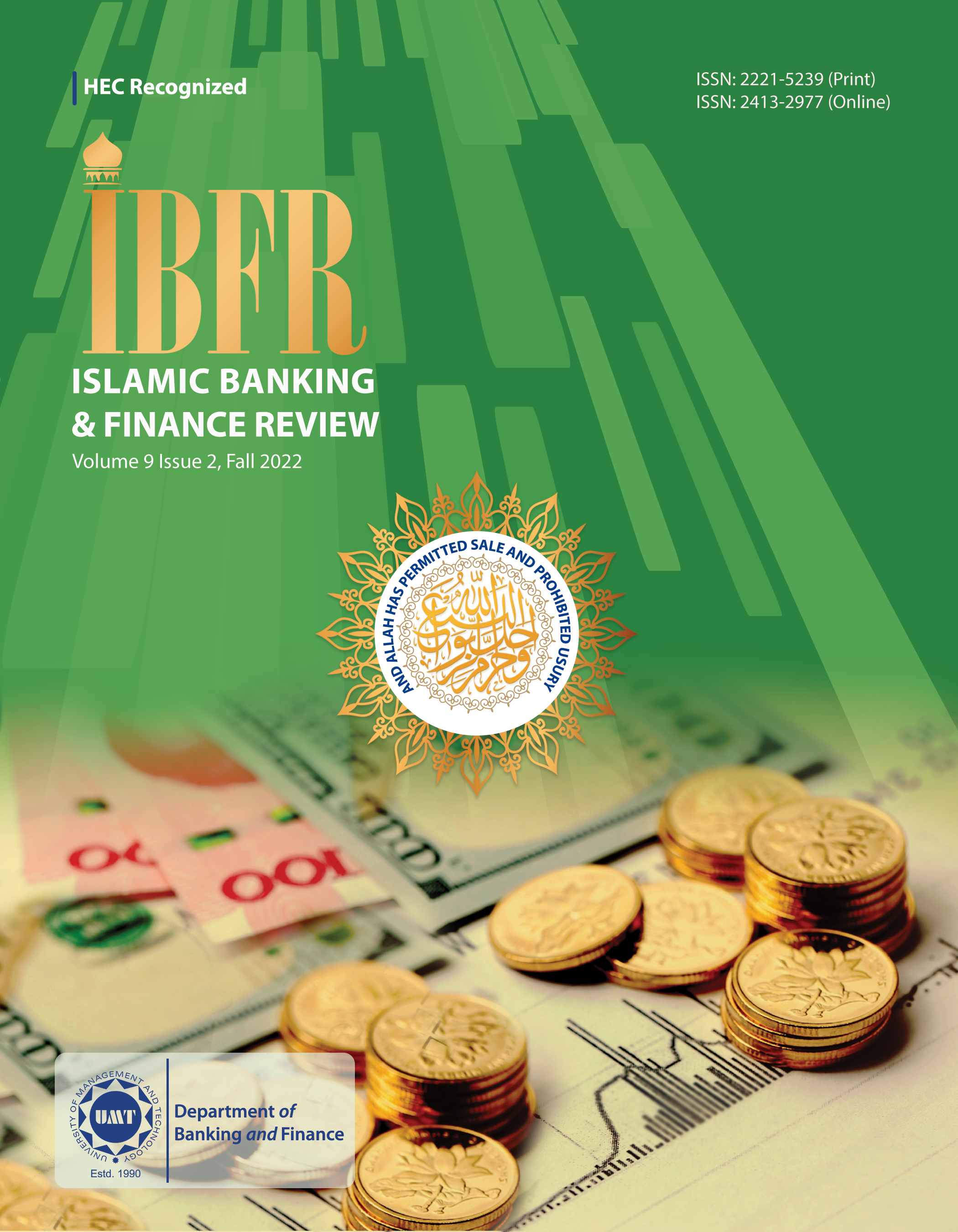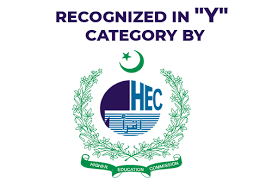Empirical Investigation of Factors Affecting the Capital Structure of Islamic Banks (IBs): Evidence from Pakistan
Abstract
 Abstract Views: 93
Abstract Views: 93
The study intends to find out the important factors that affect the capital structure of Islamic banks in Pakistan by applying the Generalized Least Square Regression (GLS) model. In this regard, the panel data from 2011 to 2019 of major Islamic banks were gathered through the financial statements of the Islamic banks. The leverage ratio was used as a dependent variable and profitability, liquidity, NDTS, Bank size, tax, solvency, growth, inflation rate and GDP were used as independent variables. The findings of the study show that the capital structure of the IBs has a positive and significant relationship with profitability, liquidity and NDTS while bank size, tax, solvency, inflation rate and GDP are negatively associated with the leverage ratio.
Downloads
References
Al-Hunnayan, S. H., (2020). “The Capital Structure Decisions of Islamic Banks in the GCC”, Journal of Islamic Accounting and Business Research, 11(4), 745-764
Akhtar, M. F., Ali, K and Sadaqat, S. (2011). “Factors Influencing the Profitability of Islamic Banks of Pakistan”, International Research Journal of Finance and Economics, 66, 125-132.
Al-Deehani, T., Abdelkarim, R. A., and Murinde, V. (1999), “The capital structure of Islamic banks under the contractual obligation of profit sharing”, International Journal of Theoretical and Applied Finance, 2(3), 243-283. https://www.worldscientific.com/doi/10.1142/S0219024999000157
Al-Kayed, l. T., Zain, S. R., and Duasa, J., (2014). “The relationship between capital structure and performance of Islamic banks”, Journal of Islamic Accounting and Business Research, 5(2), 158-181.
Amidu, M., (2007). “Determinants of Capital structure of banks in Ghana: an empirical approach”, Baltic Journal of Management, 2(1), 67-79.
Baral (1996). “Capital Structure and Cost of Capital in Public Sector Enterprises in Nepal”. Ph.D thesis. Delhi University.
Bancel, F., & Mittoo, U. R. (2004). “Cross-country determinants of capital structure choice: A survey of European firms”, Financial management, 33(4),103-132.
Beck, T., Demirgüç-Kunt, A., & Maksimovic, V. (2008). “Financing patterns around the world: Are small firms different?”, Journal of financial economics, 89(3), 467-487.
Bukair, A. A. A., (2019). “Factors influencing Islamic banks’ capital structure in developing economies”, Journal of Islamic Accounting and Business Research, 10(1), 2-20.
Butt, I., Ahmad, N., Naveed, A., and Ahmed, Z., (2018). "Determinants of low adoption of Islamic banking in Pakistan”, Journal of Islamic Marketing, 9(3), 655-672.
Chen, C. J., Cheng, C. A., He, J., & Kim, J. (1997). “An investigation of the relationship between international activities and capital structure”, Journal of international business studies, 28(3), 563-577.
De Jong, A., Kabir, R., & Nguyen, T. T. (2008). “Capital structure around the world: The roles of firm-and country-specific determinants”, Journal of Banking & Finance, 32(9), 1954-1969.
Desai, M. A., Foley, C. F., & Hines Jr, J. R. (2004). “A multinational perspective on capital structure choice and internal capital markets”, The Journal of finance, 59(6), 2451-2487.
Dickey, D. A., & Fuller, W. A. (1979). Distribution of the estimators for autoregressive time series with a unit root. Journal of the American statistical association, 74, 427-431.
Global Financial Development (GFD) Report (2014), available at: http://econ.worldbank.org/wbsite/external/extdec/extglobalfinreport/0contentmdk:23492074pagePK:64168182piPK:64168060theSitePK:8816097,00.html.
Huang, S. G., & Song, F. M. (2004). “The determinants of capital structure: Evidence from China”, China Economic Quarterly-Beijing-, 3, 395-414.
Iqbal, M., Ahmad, A., and Khan, T. (1998). “Challenges Facing Islamic Banking,” Occasional Paper no.1 (Islamic Research and Training Institute and Islamic Development Bank.
Jensen M. C., Meckling W.H., (1976). “Theory of the firm: managerial behavior, agency costs, and ownership structure”, Journal of Financial Economics, 3(4), 305– 360.
Korajczyk, R. A., & Levy, A. (2003). “Capital structure choice: macroeconomic conditions and financial constraints”, Journal of financial economics, 68(1), 75-109.
Lemmon, M. L., Roberts, M. R., & Zender, J. F. (2008). “Back to the beginning: persistence and the cross‐section of corporate capital structure”, The journal of finance, 63(4), 1575-1608.
Myers S. C. (1984). “The capital structure puzzle”, Journal of Finance, 34, 575–592.
Myers, S., and N. Majluf (1984), “Corporate Financing and Investment Decisions When Firms Have Information Investors Do not Have”, Journal of Financial Economics, 13, 187-222.
Modigliani, F, and Miller, M.H. (1958), "The Cost of Capital, Corporation Finance and the Theory of Investment”, The American Economic Review, 48 (3), 261-297.
Modigliani, F. and Miller, M.H. (1963), "Corporate Income Taxes and the Cost of Capital; A Correction”, The American Economic Review, 53 (3), 433-443.
Nelson, C. R., & Plosser, C. R. (1982). Trends and random walks in macroeconmic time series: some evidence and implications. Journal of monetary economics, 10(2), 139-162.
Phillips, P. C., & Perron, P. (1988). Testing for a unit root in time series regression. Biometrika, 75(2), 335-346.
Rajhi, W. and Hassairi, S. A., (2012). “Capital Structure and Financial Risks in Non-Conventional Banking System”. International Journal of Economics and Finance, 4(4), 252-265.
Siddiqui, M.A. and Shoaib, A. (2011), “Measuring performance through Capital structure: evidence from banking sector of Pakistan”, African Journal of Business Management, 5(5), 1871-1879
Shaukat, Rozeen, and Naveed, M. A., (2020). "Perceptions of Bankers towards Issues of Islamic Banking in Pakistan" Journal of Islamic Thought and Civilization, 10(2), 206-222.
Copyright (c) 2022 Muzammil Khurshid, Shoaib Irshad

This work is licensed under a Creative Commons Attribution 4.0 International License.
Authors retain copyright and grant the journal right of first publication with the work simultaneously licensed under a Creative Commons Attribution (CC-BY) 4.0 License that allows others to share the work with an acknowledgement of the work’s authorship and initial publication in this journal.












